
PREV ARTICLE
NEXT ARTICLE
FULL ISSUE
PREV FULL ISSUE
NOTES FROM E-SYLUM READERS: NOVEMBER 1, 2015Removing Price Stickers From Books
I want to let the people who sent in suggestions that it is very much appreciated!! I am an avid reader as I am disabled and probably read about 30 plus books per month. It is so frustrating to try to remove the stickers from these books especially when they are new or put over a part of the book where it is giving you a small synopsis of the story. Anyway please thank you all very much!! To read the earlier E-Sylum article, see:
Coins and Stamp Department Photos Sought
I'd like to know if any readers have photos of the coin and stamp departments that used to be a fixture of many department stores until the 1980s. I could really use such images for my current book project on Robert Friedberg and the coin albums he published that were sold in such stores.
Great idea! Can anyone help? -Editor
Were Green & Russell Selling 1761 Coronation Medals?
A price of "6 coppers" ought to be three pennies. I believe farthings were not used in the colonies, and 1 1/2 pence (i.e. 6 farthings, full retail) may not have been enough to generate a profit, after shipping. I would assume these were 1761 coronation medals, of which several varieties were privately made as inexpensive souvenirs, with accoladed busts of George III & his queen. I have handled many dozens, but never one in White Metal. Perhaps the pieces are brass and silvered brass. I doubt it would be possible to ascertain what medal(lette) G & R were selling. To read the earlier E-Sylum article, see:
An Early U.S. Mint Canvas Coin Bag
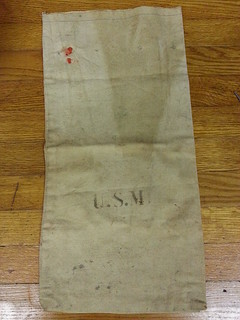 
Paul Kluth writes: These images were taken of an early U.S. Mint canvas bag for use to ship/hold an unknown denomination and date of newly struck coins. Shared with me by a collector of Civil War artifacts and obtained in an estate collection of Civil War relics, I am hoping some readers of The E-Sylum can shed some light on the likely age of the bag along with any additional information. The bag's owner and I are thinking the bag is from the late 19th or early 20th century, but maybe it is even earlier? The "red wax" remaining on the upper front of the bag above the printed U.S. M is intriguing to say the least. Was this how an official stamp was used to mark/identify the bag after hot wax was applied? Thanks!
Interesting. Anyone have a clue? What is the earliest known mint bag to still exist? -Editor
To read an earlier E-Sylum article on a related topic, see:
Query: The Disbursement of the Dewitt Smith Collection
With regard to Brand’s purchases from the Dewitt Smith collection, I do not remember a Templeton Reid $25 mentioned in the journals. Virgil Brand did get Smith’s colonials and copper cents, 1792 and gold dollar and Stella patterns, $3 gold and territorial gold and related patterns. The silver was not part of the purchase which apparently went to Granberg according to several Breen pedigrees. I am unaware of just how his collection was split up. Has anyone else heard of how the collection was disbursed and is there an inventory of the silver? To read the earlier E-Sylum article, see:
Query: The National Oceanic and Philatelic Society
All I can come up with for your reader's query is this certificate on my studio wall. Somewhere in the catacombs of my flat files is a letter from the NOAA Space Philatelic Society with their address etc. 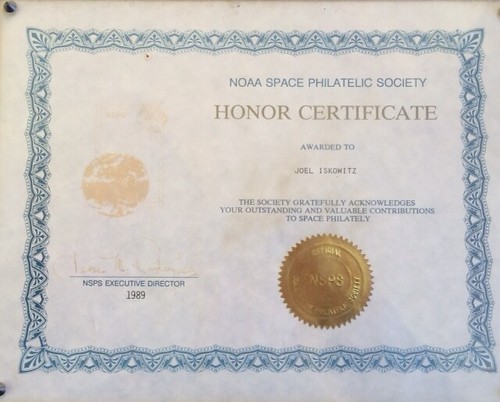
So it's actually the NOAA (National Oceanic and Atmospheric Administration) Space Philatelic Society. Does anyone recall this
organization? Online searches are still coming up empty. Just curious... -Editor
To read the earlier E-Sylum article, see:
More on the H. R. C. Clock Token
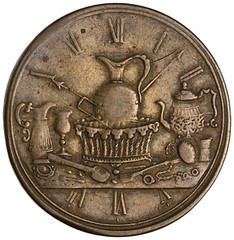 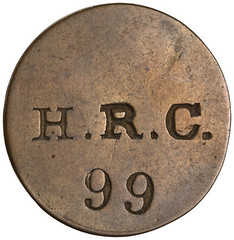
Regarding the H. R. C. token, Larry Dziubek writes: I believe it is a “Claim Check” from a watchmaker / silversmith. They do not usually have the pictorial designs. The initials are the shop owners and the number is for the item. There are the clock numbers around outside and a pocket watch on table. The liquid container types could all be made of silver; pitcher-tea pot-goblet-& glass. There is a “silver” fork and ladle and a basket that could be made of metal. The trick is to figure out the town of origin and check some city directories for a merchant with matching initials in that occupation. In the new Civil War Token Storecard book there is a similar item ( ILL 150-bA-1a on page 97). It is from Chicago and was issued by a watchmaker named Claudius G. Avery. 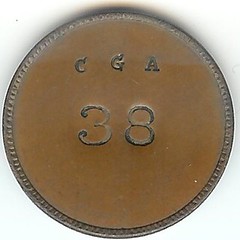 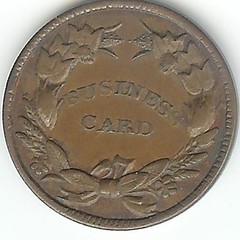
To read the earlier E-Sylum article, see:
THE BOOK BAZARREWayne Homren, Editor The Numismatic Bibliomania Society is a non-profit organization promoting numismatic literature. See our web site at coinbooks.org. To submit items for publication in The E-Sylum, write to the Editor at this address: whomren@gmail.com To subscribe go to: https://my.binhost.com/lists/listinfo/esylum All Rights Reserved. NBS Home Page Contact the NBS webmaster 
|